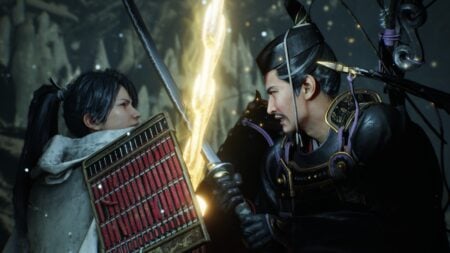Skip To...
The early years of the 20th century are much more, well… riveting than we could have anticipated. Loads of family drama, frequent trips to the bar that leave us with massive hangovers, and dark, ethereal demons that choose to fight on our side if we have the strength to tame them. The Thaumaturge takes us into a whole different era in time where we must discover the hidden secrets of Warsaw through this story-driven, singleplayer RPG. While Wiktor Szulski battles the unseen and discovers clues, you’ll fight alongside him to help take back what is rightfully his.
The Thaumaturge: Unlocking the Unseen Through Perception

The Thaumaturge is a fascinating singleplayer RPG that features turn-based combat, unique clues for you to perceive beyond what others are capable of, and demon-like creatures called Salutors. Conceptually, the main idea is that you must use your Perception to discover things that others cannot, all while getting to the bottom of the unfinished business your father left for you after his passing. You get to experience a bit of beast-taming, though it’s not too similar to other games like Pokemon, as well as puzzle-solving and a bit of detective work. Your choices define how you play the game and how successful you will be in finding your father’s Black Grimoire.
Story: Daddy Left Some Unfinished Business

The game’s story focuses on Wiktor Szulski, a Thaumaturge. What on earth is that? Well, allow us to explain. In essence, a Thaumaturge has the ability to perceive more than the average person can, allowing them to see Salutors, Flaws, and clues that would otherwise be entirely hidden. However, despite Wiktor’s abilities, he still has some trouble working alone, which is where Rasputin, a preacher with healing abilities, comes into play. Together, Rasputin and Wiktor are able to discover the secrets surrounding Salutors and tame them.
Within The Thaumaturge, Wiktor learns that his father — whom he never truly cared for — has passed away and, much to his son’s surprise, leaves his Black Grimoire to him. The Black Grimoire was Daddy’s beloved magic book, the most important tool used by a Thaumaturge. Unfortunately, the Black Grimoire has gone missing. You weren’t able to find it in his belongings or the place of his death, so you must uncover the secrets surrounding it and retrieve it for yourself, Wiktor.
Wiktor and Rasputin travel the streets of Warsaw with the help of Ligia, Wiktor’s twin, searching for the Black Grimoire. Through combat, intriguing conversation and dialogue, exciting Salutor hunts, and more than a couple of trips to the tavern that leave you a bit ‘out of it,’ you get to experience the vast and in-depth story that The Thaumaturge has to offer. The linear narrative drives your story in a near-straight line with slight deviations splintering off depending on your dialogue choices. That takes little away from the depth you experience throughout the adventures of Wiktor Szukski, however.
Gameplay: Simple Complexities

The concept is simple: find clues to discover Flaws, locate Salutors, fight and tame them while discovering the next step to the secrets behind Father’s missing Black Grimoire. The gameplay is simple, yet complex at times. Using either your mouse or a keyboard, you roam around the map searching for clues using a simple click on your right mouse button, then keep track of your timing in turn-based combat.
Using your Perception, you have an advantage in any situation. Whether it’s with finding clues, drawing conclusions, and discovering Flaws, or even something as basic as kicking the butts of the nearest NPCs who decided to pick a fight with the wrong Thaumaturge. The process is simple, yet time-consuming. However, with the use of the Entries feature in The Thaumaturge, things get a tad more simplified. The Entries feature allows you to go back into your journal review things you’ve already learned about the game and reread through tutorial steps.
Being able to wander the streets of Warsaw in 1905 and get down to the root of the locals’ issues as well as your own is intriguing. While finding clues might usually be difficult, your Perception allows you to see things others might not, making it easier and giving you a bit of backstory whenever you discover a new clue or draw conclusions. Let’s not forget about the combat, either.
Sadly, combat in The Thaumaturge can occasionally be tedious and repetitive, though it’s not as common as you’d think. Over 20+ hours of gameplay, I found myself in several fights with crabby locals, but as far as major fights, I only encountered a small handful. I found the combat to be a much more minor aspect of the game than I was hoping for.
As to be expected, it’s all turn-based, but there are some important features you must look out for. For instance, you can slow down the attacks of others, which can be seen above the combat scene, and you must lower your opponent’s Focus entirely before a heavy attack can be played. Though, that’s about all you have to worry about. It’s the same thing. Every. Single. Time. The only exception, of course, is when you go up against Salutors who throw literal waves of enemies at you, which is rare and only occurs a handful of times.
Graphics & Audio: Dark and Historical

The Thaumaturge takes place in 1905 Warsaw, which is a really unique and interesting locale. That being said, you shouldn’t expect too much color or “prettiness” in the visuals department. In fact, I think the graphics were just a bit undercooked and underwhelming overall. While they fit the gloomy tone of the game, they’re also just not very exciting or eye-catching, for the most part. After some time it becomes rather boring to stare at the screen and see the same bland colors mixing together. However, I think the Salutor models were done beautifully, as they capture the ominous aesthetic perfectly.
When it comes to the audio within The Thaumaturge, I can confidently say that the in-game music is exciting during combat and high-intensity moments, and relaxing and calm during more chill moments in your gameplay. You always know when something wild is about to happen, which is a great feature. Additionally, I think the music fits the style of The Thaumaturge well. The dialogue from each of the characters is clear and well-delivered. Overall, I think the audio was fantastic.
Conclusion: Loads of Potential

Naturally, there are some things I’d like to see done better, as well as some things that I believe were done quite well. The audio is beautiful, but the graphics are rather lacking. Don’t get me wrong, in some areas, having less is definitely more when it comes to graphics. I love the simple HUD that prevents you from having to deal with absolute chaos all over the place, but I also wish that there could be more color. After some time, the visuals begin to look increasingly dull and simply lack variety and excitement.
While I believe that The Thaumaturge has the potential to be a huge hit, potential doesn’t mean it’s quite there yet. The idea behind the story is beautiful and can be enjoyed very thoroughly. The mechanics are a rather unique twist on things I’ve seen in the past, and in this day and age, we all know that ‘unique’ is something that’s pretty hard to come by. The compelling detective take on the story definitely brings back some of the excitement that the graphics take away from, as well as the cool and captivating stories that come along with every new clue you discover. Overall, I enjoyed The Thaumaturge, I just wish there was a bit ‘more’ in certain areas; some more exciting and dynamic graphics, a bit of diversity in the gameplay loop, and a bit more engaging combat.
The Thaumaturge
The Thaumaturge shows quite a bit of potential, but lacks in some of the most important areas.
The Good
- Wonderful music
- Intriguing dialogue and story
- Simple HUD and game design
The Bad
- Loads of repetition
- Boring combat that doesn't hold much importance
- Dull graphics







